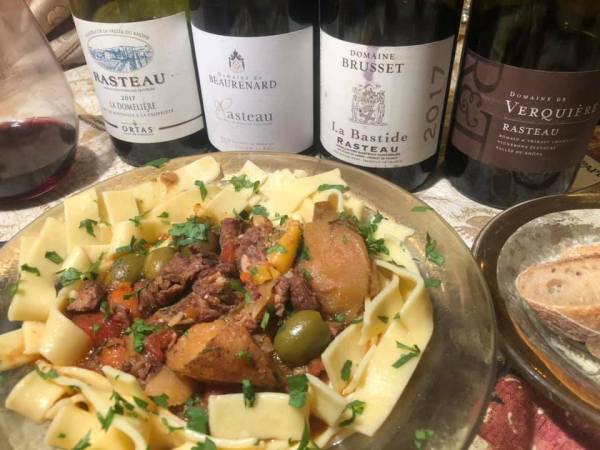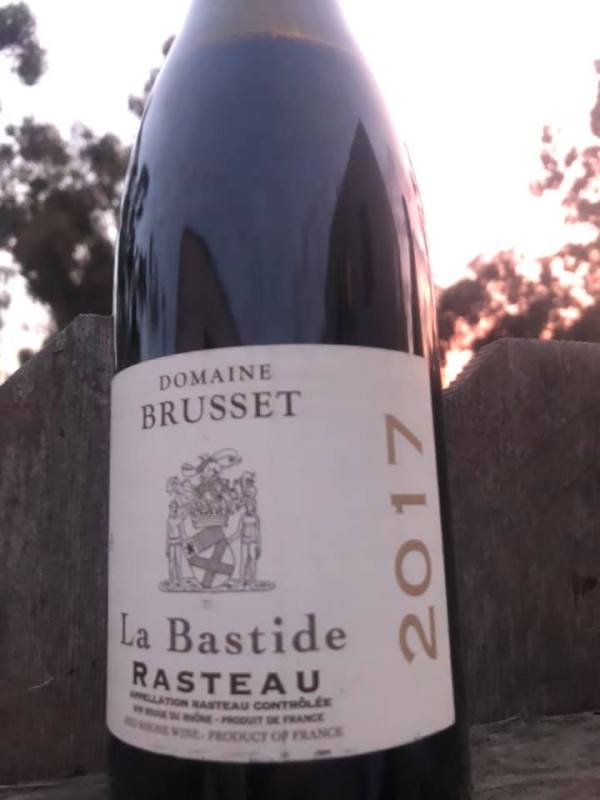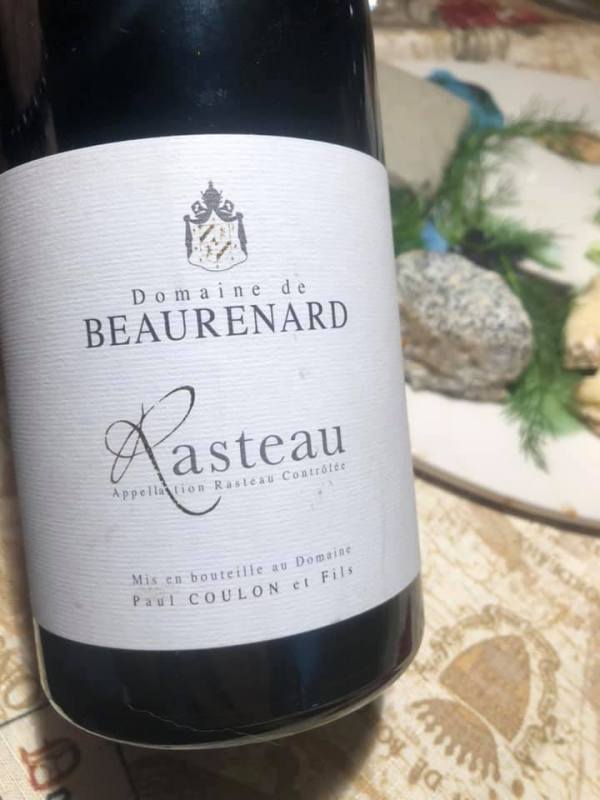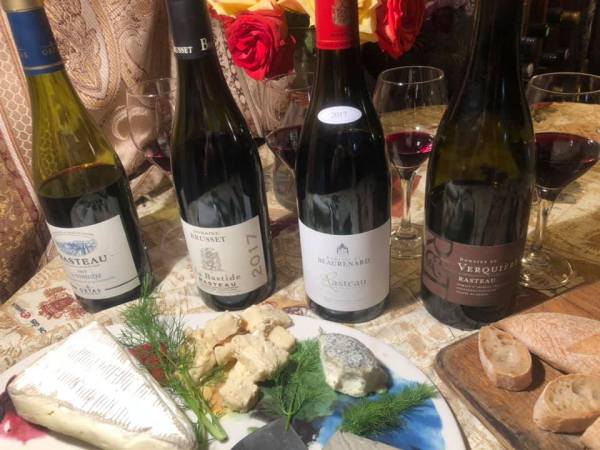
Rasteau is a small AOC in the Rhône region of southern France known for making sweet fortified wines, and since 2010, red wines. This means that in 2020, Rasteau will celebrate 10 years of Cru status for their dry reds.
HISTORY
Wine has long been produced in Rasteau: in the Middle Ages, wines from Rasteau were a favorite of the bishops of Vaison-la-Romaine. By the 18th century, Rasteau was famous for fortified wines but in 1870, phylloxera hit. Vignerons reestablished vineyards in 1925, and they received AOC status for their sweet wines soon after. Today Rasteaus is a village with a charming medieval atmosphere with cobbled streets, a fort, and the ruins of a castle.
TERROIR
The landscape of Rasteau has gentle hills and valleys shaped like the tines of a rake which in French is the word râteau. The rake is in the shape of an amphitheater which protects the vineyards from the intense mistral winds that race down from the north. These mistral winds are also a blessing as they help keep the vines healthy. The vineyards climb over 1000 feet in elevation, with different soils along the way much like a layer cake. Near the top are the “pudding stones” which collect warmth during the day and release it over night.
WINES
According to the rules for the AOC, Rasteau wines include 50% minimum of Grenache and no more than 20% of Syrah and/or Mourvèdre. They say that Grenache Noir adds finesse, body and roundness while the Syrah supplies structure, acidity and aromatic complexity, and the Mourvèdre brings structure, tannins and balance. Below you’ll see a selection of four wines from Rasteau that we tasted and if you scroll down, you’ll find links to more comments about Rasteau by another fifteen winophiles.
- Domaine de Beaurenard Rasteau Rouge 2016
80% Grenache, 17% Syrah, 3% Mourvèdre - Domaine Brussett Rasteau La Bastide Rogue 2017
80% Grenache, 20% Mourvèdre - Domaine de Verquière Rasteau Rouge 2017
70% Grenache 30% Syrah - Cave de Rasteau La Domellière Rouge 2017
70% Grenache, 20% Syrah, 10% Mourvède
MENU: Lamb Daube
Michel Blanc of Chateauneauf du Pape who we met in France at the Wine Tasting Championships suggested that we pair these wines with a beef or lamb Provençal daube. As I love lamb with Rhone blends like a GSM (grenache-syrah-mourvedre blend), going with lamb sounded like a winner to me.
But what in the world is DAUBE?
I researched a number of recipes as well as wikipedia to learn that “a daube is a French or Provençal stew made with inexpensive beef braised[2] in wine, vegetables, garlic, and herbes de Provence, and traditionally cooked in a daubière,[1] a braising pan.[3] A traditional daubière is a terracotta pot that resembles a pitcher, with a concave lid. Water is poured on the lid, which condenses the moisture inside, allowing for the long cooking required to tenderize lesser cuts of meat.”
Ingredients in addition to carrots, celery and onion that showed up in several recipes include olives, fennel, citrus peel, and bacon. I was also intrigued by recipes that called for juniper berries and baking spices but we didn’t go in that direction, preferring the fennel and bacon idea. Recipes mentioned marinating the meat overnight and cooking for many hours then serving it the following day to marry the flavors better. The amount of wine varied from one cup to one bottle, and while it was originally white wine especially with lamb, most recipes today call for red or even a bottle of rose. Daube is served on grits, parsnip puree, egg noodles and more.
Since we didn’t have several days but only a few hours, Sue adapted the recipe for the instant pot, and it came out so heavenly that I think it was one of my husband’s all time favorites. Remarkably, in all these years, we’ve never done a traditional stew although last spring we did a Navarin, which is a French spring stew type dish that we made in the instant pot and really enjoyed with French rhone wine.
As we typically do, we tasted each wine three times: alone, with charcuterie that included a triple creme brie, salamis, and goat cheese I brought back from France, plus brie and pate purchased from Sprouts. We tasted the wines in reverse order from how they are described below– from least expensive to most expensive.

Domaine Brussett Rasteau La Bastide Rogue 2017 SRP $21
80% Grenache, 20% Mourvèdre
The Brussets combine traditional winemaking from their 1940s roots with new technologies. In addition to Rasteau, their 172 acres are in Gigondas, Cairanne, Côtes du Rhône, and Ventoux. The founder’s son Daniel and grandson Laurent create classic wines with modern techniques today.
Color: Pomegranate juice, pale fuchsia rim.
Nose: I loved the nose on this wine, rich perfume, carnations, a bit of musk, plum, violets, forest floor; the nose is so rich and lovely, as it opens up some mint shows through, and a bit of Thai curry.
Palate: This is a fuller bodied wine than the others we tasted. Plum, saline, bold acidity, nice sapidity; this wine makes you salivate!
Pairing: Once again, French wine with French cheese is so amazing! We loved this wine with our mountain goat milk cheese coated with herbs and it was really good with the cured sausage bites — we brought both back from France.
French wine, French food, so amazing!
With pate, it is as decadent as pumpkin pie. It brings out a custard like a mushroom custard quiche, on the finish it brings out so many baking spices in the wine it is like a pumpkin pie.
This wine loves the daube: It loves the lamb. It loves the root vegetables, the herbs and citrus as well as the olives. It’s a complex wine for a complex stew. Thank you Michel for recommending this meal to pair with the wines.

Domaine de Beaurenard Rasteau Rouge 2016 SRP $18
alc 15%; certified biodynamic; 80% Grenache, 17% Syrah, 3% Mourvèdre
As of 2010, all of their vineyards are certified biodynamic or organic; 80 acres are in Chateauneuf-du-Pape AOC and 60 acres are in the Rasteau AOC. This seventh generation focuses on biodiversity, maintains low yields for more concentration, and utilizes native yeasts.
Color: Think of a translucent cranberry sauce. The rim is just a lighter tinge of the body of the wine.
Nose: Strawberry rhubarb pie, mostly rhubarb, and a bit of strawberry, nice earthiness.
Palate: This does not taste like a 15% alcohol wine. It is velvety smooth. Rhubarb comes across the palate with silty earthen notes, with a bit of tobacco, snuff, river stone
Pairing: Great with cured meats, a salami really brings out the fruit in the wine, with our funky French cheese it is pure perfection, beautiful with the pate as well, it really brings out lovely baking spices and fruit in the wine. The brie brought out a lovely tangy cherry fruit in the wine. The rind of the brie adds a nice complexity to the wine. While this was our favorite wine with the cheese plate and on its own, but with the stew it was good, but it did not shine, it seemed that the complexity of the food overwhelmed the wine and just made it sweet and fruity. I feel that maybe duck with this may be better.

Domaine de Verquière Rasteau Rouge 2016 SRP $16
70% Grenache 30% Syrah
Four generations in Sablet have made wine at Domaine de Verquière on their 110-acre family estate. Since 2014, all vineyards are certified organic.
Color: Somewhat translucent, ruby red with a light pink rim
Nose: Cherry, plum, cranberry, violet, rich earth, tobacco, leather. I thought it kind of smells like Christmas. evergreen, a little clove.
Palate: Dry, tart fruit, cranberry, minerals, long lingering finish. There is a lot of acidity on the palate, while you can sip it without food, it really yearns for food.
Pairing: Good with cured meats, and French cheeses, We felt it was best with a mild brie. Super fun with the citrus and the herbs in the daube. It also likes the rich root vegetables in the stew.
If you were going to have this wine at Thanksgiving, serve it with squash, potatoes, or other root vegetables.

Cave de Rasteau La Domellière Rouge 2017 SRP $15:
70% Grenache, 20% Syrah, 10% Mourvède
Cave de Rasteau was founded in 1925 making it one of the oldest cooperatives in the Southern Rhône Valley. Today it has 180 growers.
Color: Ruby red, blood red, platinum, clear rim, possibly the palest of pink.
Nose: Lots of French funk on the nose, pine sap, a bit of rhubarb, cherry cough drop. Very little fruit at first; it’s mostly just funky.
Palate: Sulphur, cherry fruit, a bit of black licorice, long lingering mineral finish. This wine hangs out for a long time.
Pairing: Pate brings out a lovely baking spice in the wine. we still had a bit of our French cheese left from our trip, and they harmonized so well with the wine. We would have never guessed that this was the same wine when it meets up with these cheeses, it takes on a whole new character. This wine loves the lamb in the daube, and the citrus component in the daube plays off the wine really nicely. It also loves the thyme and rosemary in the stew.
Join the French #winophiles in celebrating Rasteau’s 10th birthday in 2020! Twitter questions follow links to participants blogs. Read the invitation here.
- Camilla from Culinary Adventures with CamShares “A Birthday Tradition + Side-by-Side Sips of Domaine de Verquière Rasteau”
- Cathie from Side Hustle Wino“Getting to Know the Wines of Rasteau”
- David from Cooking ChatWrites About “Chicken Lentil Stew and Rhone Wine from Rasteau”
- Deanna from Asian Test Kitchentells us how to “Become a Rasteau—farian”
- Gwendolyn from Wine Predatorsays “Go Grenache, Go Rasteau: Four Paired with Lamb Daube”
- Jane from Always RavenousWrites About “Flavors of Provence Paired with Rhône Rasteau Wines”
- Jeff from Food Wine ClickExplains “Rasteau and the Côtes du Rhône Quality Pyramid”
- Kat from The Corkscrew ConciergeExplain How She is “Expanding my Rhône Valley Palate with Rasteau Wine”
- Linda from My Full Wine GlassWrites about “Basking in the Glow of Rasteau” #Winophile
- Liz from What’s in That BottleSays, “You Like Big Reds? Get to Know Rasteau”
- Lynn fromSavor the Harvestwrites about “Rhone Valley Rasteau Cru – A New Generation Wine With Duck Confit #winophiles”
- Martin from EnofylzWrites About “Getting To Know Rasteau”
- Nicole from Somm’s TableShares “Five Nights of Rasteau”
- Pinny from Chinese Food & Wine PairingsWrites About “One Rabbit, Two Turkey Drumsticks and Four Rasteau Wines”
- Payal from Keep the Peaswrites about “Rasteau: Not So Rustic in the Southern Rhone”
- Robin from Crushed Grape Chronicleswrites about “Fall, Thanksgiving and the flavors of Rastea
- Rupal from Syrah Queenwrites, “Rasteau – Exploring The Gems of Southern Rhone”
- Wendy from A Day in the Life on the FarmShares “A German-Style Shepherds Pie with a French Rasteau”
TWITTER QUESTIONS for Rasteau 11-16-19
8am Pacific/10:00 Welcome to Rasteau! Who was already familiar with the wines of Rasteau?
8:05/10:05:Rasteau is a village in the Southern Rhône Valley that got promoted to Cru status in 2009. How do Rasteau wines compare to other Southern Rhône Cru wines?
8:10/10:10 Rasteau is one of the lesser-known of the 9 other Crus in the Southern Rhone. Why do you think that is?
8:15/10:15 Rasteau wines must be at least 50% Grenache & 20% each Syrah and Mourvedre. What do you think each grape brings to the party?
10:20 How do you think Rasteau wines differ from similar blends from other parts of the world?
10:25 Let’s talk age and vintage. Most of the samples were 2016 and 2017 – so pretty young. What were your impressions? Did anyone try an older Rasteau?
10:30 The Crus of the Rhône Valley are known for the terroir that is expressed in the wines. How did the terroir come through in these wines?
10:35 Has anyone tasted Rasteau wines against other Crus in the Southern Rhone? Differences? Similarities?
10:35 Let’s talk food! What did you pair with your Rasteau wines? Let’s see your food pics!
10:40 Did anyone do a pairing that just didn’t work?
10:45 Anyone ever visited Rasteau? Tell us about it! Pictures please!
10:55 Any final thoughts? Mark your calendars now to join us on Dec. 21 for Vouvray, hosted by Jeff Burrows

I had heard of Daube before and kind of thought it was a stew, but had no idea about the cooking vessel! Of course I had to google it right away to get a visual. I see they are also made in copper. This region seems to cross borders between Southern Rhône and Provençe in it’s styles. The dish sounds delicious as do the wines.
LikeLiked by 1 person
While it would be cool to have a daube around, I think we’ll stick with the instant pot!! And yes it is so far south it makes sense that the cuisine is a cross between them.
LikeLike
I’ve often wondered about the history and technique of Daube. I’m sure the wines were just great with the dish. Thanks for sharing!
LikeLiked by 1 person
It was really interesting discovering it for myself! New dish!
LikeLike
After reading about pudding stones on the Côtes du Rhône website, I’ll always remember galets! Your Instapot Daube… might have to take the plunge and get an instapot! They keep popping up and it’s definitely the time of year for warming meals and red wine. Interesting the Beaurenard didn’t really work with the stew. You’ll have to let us know if you try it with duck.
LikeLiked by 1 person
The Beaurenard had 15% alcohol so that contributed I think. We really wanted to love it because it is biodynamic! And we did in general but the $21 one was significantly more complex and better with the food.
LikeLike
You had me at bacon and fennel with that Daube! I love reading about how the wines changed with different foods.
LikeLiked by 1 person
We were surprised that the bacon was so subtle in it and so was the fennel. I love the idea of putting it on parsnip puree instead of noodles but the noodles were great how the gravy covered them nd how the gravy from the lamb went so well with the wines.
LikeLike
What a great post – such great information! I agree on the well integrated alcohol on these wines – 2 of mine were 15% and I would never have guessed.
LikeLiked by 1 person
Thanks! I didn’t really investigate the weather that year — might have contributed to the high alcohol.
LikeLiked by 1 person
Wow, you and Sue really put the wines through the ringer! We visited Ch. Beaurenard on our Southern Rhone trip a few years ago. Really a nice visit and we enjoy their wines a lot. We get some in the Twin Cities.
LikeLiked by 1 person
We’ve learned that this is the best way to understand the wines — tasting on their own (and deciding the order), tasting several wines side by side, then seeing how the wines are with food… we love trying wines with cheeses and then with the actual dinner!
LikeLike
I wasn’t familiar with Daube but sounds like something I’d definitely try.
LikeLiked by 1 person
It’s great! Enjoy!
LikeLike
I also made a lamb daube, and yes, it was a perfect pairing with the Rasteau wines! I love your idea of doing a charcuterie board for tasting and pairing with the wines. I am all about how wine and food interact with each other. (I also love cheese😉)
LikeLiked by 1 person
We’re cheese fiends also! But more than that, cheese is such the perfect foil for wine!
LikeLike
Lamb daube sounds delicious for these wines! Sound like some good adaptations for the time you had too.
LikeLiked by 1 person
It was! And fun to try a new recipe — so easy to do these slow cooked and braised meat menus with an instant pot!
LikeLike
How about that! We had the same wines. We both had lamb, and we both converted the recipes to Instant Pots. I thought the wine i chose paired well with the lamb! Cheers
LikeLiked by 1 person
Great minds think alike! Cheers!
LikeLike